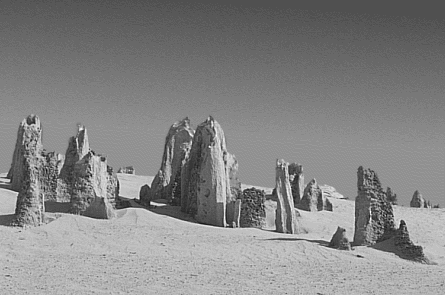
Posted on 12/26/2006 1:11:03 PM PST by cogitator
I saw a picture of this highly abnormal (aboriginal?) place, and decided it was quite worthy of the Christmas break Geology Picture of the Week. For added artistic content, both a black-and-white and color photo are provided. The link has neither; it's a Web site about the national park in Australia, if you're interested in going.


For a better photographic treatment, look for 7 pictures of Nambung National Park on the page below, which has some other nice Australia images. (I can't link these pictures onto FR.)
** pinnacle-ping **
Your second link has a fascinating explanation of how the pinnacles were formed, if you enlarge the picture titled "Namburg National Park 1." They're believed to be natural formations, as opposed to those of Easter Island.
Just to make sure you knew, I was aware they were natural. It just reminded me of Easter Island.
Copied here for benefit of others (I didn't see that!). Thanks!
----
In the Pinnacles Desert, right in the heart of Nambung National Park, thousands of huge limestone pillars rise out of a stark landscape of yellow sand. In places they reach up to three and a half metres tall. Some are jagged, sharp-edged columns, rising to a point; while others resemble tombstones.
The raw material for the limestone of the pinnacles came from sea shells in an earlier epoch rich in marine life. These shells were broken down into lime-rich sands which were brought ashore by waves and then carried inland by the wind to form high, mobile dunes. Three old systems of sand dunes run parallel to the WA coast, marking ancient shorelines.
The oldest of these, known as the Spearwood dune system, is characterised by yellow or brownish sands. In winter, rain, which is slightly acidic, dissolves small amounts of calcium carbonate as it percolates down through the sand. As the dune dries out during summer, this is precipitated as a cement around grains of sand in the lower levels of the dunes, binding them together and eventually producing a hard limestone rock, known as Tamala Limestone.
At the same time, vegetation that became established on the surface, aided this process. Plant roots stabilised the surface, and encouraged a more acidic layer of soil and humus (containing decayed plant and animal matter) to develop over the remaining quartz sand.
The acidic soil accelerated the leaching process, and a hard layer of calcrete formed over the softer limestone below. Cracks which formed in the calcrete layer were exploited by plant roots. When water seeped down along these channels, the softer limestone beneath was slowly leached away and the channels gradually filled with quartz sand. This subsurface erosion continued until only the most resilient columns remained. The Pinnacles, then, are the eroded remnants of the formerly thick bed of limestone.
As bush fires denuded the higher areas, south-westerly winds carried away the loose quartz sands and left these limestone pillars standing up to three and a half metres high.
Although the formation of the Pinnacles would have taken many thousands of years, they were probably only exposed in quite recent times. Aboriginal artefacts at least 6,000 years old have been found in the Pinnacles Desert despite no recent evidence of Aboriginal occupation. This tends to suggest that the Pinnacles were exposed about 6,000 years ago and then covered up by shifting sands, before being exposed again in the last few hundred years. This process can be seen in action today - with the predominantly southerly winds uncovering pinnacles in the northern part of the Pinnacles Desert but covering those in the south. Over time, the limestone spires will no doubt be covered again by other sand drifts and the cycle repeated, creating weird and wonderful shapes over and over again.
(This is where the Sha Ka Ree sequences of Star Trek 5: The Final Frontier were shot.)
Very cool place name.
Should be in a book title.
Harry Potter and the Pinnacles of Nambung?
Kinda looks lik my backyard after a great New Years Party!! Oh well, Happy New Year anyway.
Disclaimer: Opinions posted on Free Republic are those of the individual posters and do not necessarily represent the opinion of Free Republic or its management. All materials posted herein are protected by copyright law and the exemption for fair use of copyrighted works.